Mechanics-Seepage Experimental and Simulation Study of Gas-Bearing Coal under Different Load Paths
Abstract
1. Introduction
2. Experimental Section
2.1. Specimen Procurement and Preparation
2.2. Experimental Apparatus
2.3. Experimental Methods
3. Results and Analysis
3.1. Strain and Strength Characteristics
3.2. Permeability Evolution Characteristics
4. Numerical Simulation of Crack Characteristics
4.1. Model Construction
4.2. Determination of Coal Meso-Mechanical Parameters
4.3. Crack Number Characteristic Analysis
5. Conclusions
Author Contributions
Funding
Data Availability Statement
Conflicts of Interest
References
- Xie, H.; Gao, M.; Zhang, R. Study on the mechanical properties and mechanical response of coal mining at 1000 m or deeper. Rock Mech. Rock Eng. 2019, 52, 1475–1490. [Google Scholar] [CrossRef]
- Yuan, L. Control of coal and gas outbursts in Huainan mines in China: A review. J. Rock Mech. Geotech. Eng. 2016, 8, 559–567. [Google Scholar] [CrossRef]
- Wang, K.; Guo, Y.; Wang, G.; Du, F. Seepage and Mechanical Failure Characteristics of Gas-bearing Composite Coal-Rock under True Triaxial Path. J. China Coal Soc. 2022. [Google Scholar]
- Zhang, C.; Xu, J.; Peng, S. Dynamic behavior of gas pressure and optimization of borehole length in stress relaxation zone during coalbed methane production. Fuel 2018, 233, 816–824. [Google Scholar] [CrossRef]
- Wang, K.; Du, F.; Zhang, X.; Wang, L.; Xin, C. Mechanical properties and permeability evolution in gas-bearing coal-rock combination body under triaxial conditions. Environ. Earth Sci. 2017, 76, 815. [Google Scholar] [CrossRef]
- Du, F.; Wang, K.; Zhang, X. Experimental study of coal-gas outburst: Insights from coal-rock structure, gas pressure and adsorptivity. Nat. Resour. Res. 2020, 29, 2481–2493. [Google Scholar] [CrossRef]
- Du, F.; Wang, K. Unstable failure of gas-bearing coal-rock combination bodies: Insights from physical experiments and numerical simulations. Process Saf. Environ. Prot. 2019, 129, 264–279. [Google Scholar] [CrossRef]
- Chen, Y.; Xu, J.; Peng, S.; Zhang, Q.; Chen, C. Strain localisation and seepage characteristics of rock under triaxial compression by 3D digital image correlation. Int. J. Rock Mech. Min. Sci. 2022, 152, 105064. [Google Scholar] [CrossRef]
- Chen, C.; Xu, J.; Okubo, S.; Peng, S. Damage evolution of tuff under cyclic tension–compression loading based on 3D digital image correlation. Eng. Geol. 2020, 275, 105736. [Google Scholar] [CrossRef]
- Yin, G.; Li, W.; Li, M. Experimental study of mechanical properties of coal containing methane under different loading-unloading conditions. Chin. J. Rock Mech. Eng. 2013, 32, 892–901. [Google Scholar]
- Wang, Y.; Xie, H.; Chen, S. Petrophysical and Mechanical Properties of Complex Structure Coalbed Methane Reservoir: A Laboratory Investigation. Rock Mech. Rock Eng. 2022, 1–19. [Google Scholar] [CrossRef]
- Zhao, H.; Wang, J. Experimental study of evolution law of mechanical properties of coal containing gas under unloading confining Pressure. Rock Soil Mech. 2011, 32 (Suppl. S1), 270–274. [Google Scholar]
- Wang, G.; Xue, D.; Gao, H. Study on permeability characteristics of coal rock in complete stress-strain process. J. China Coal Soc. 2012, 37, 107–112. [Google Scholar]
- Li, X.; Yin, G.; Cai, B. Experimental study on deformation and seepage properties of outburst coal samples under cyclic loading. Chin. J. Rock Mech. Eng. 2010, 29 (Suppl. S2), 3498–3504. [Google Scholar]
- Cao, S.; Bai, Y.; Li, Y. Experiments of coal’s gas seepage with outburst dangers. J. Chongqing Univ. 2011, 34, 91–95. [Google Scholar]
- Xue, D.; Zhou, H.; Wang, Z. Failure mechanism and mining-induced mechanism of coal a under different loading rates. J. China Coal Soc. 2016, 41, 595–602. [Google Scholar]
- Chaudry, M.A.; Wriggers, P. On the computational aspects of comminution in discrete element method. Comput. Part. Mech. 2018, 5, 175–189. [Google Scholar] [CrossRef]
- Zhu, F.; Zhao, J. A peridynamic investigation on crushing of sand particles. Geotechnique 2019, 69, 526–540. [Google Scholar] [CrossRef]
- Tan, X.; Hu, Z.; Cao, M.; Chen, C. 3D discrete element simulation of a geotextileencased stone column under uniaxial compression testing. Comput. Geotech. 2020, 126, 103769. [Google Scholar] [CrossRef]
- Indraratna, I.; Thakur, P.; Vinod, J.S. Experimental and numerical study of railway ballast behavior under cyclic loading. Int. J. Geomech. 2010, 10, 136–144. [Google Scholar] [CrossRef]
- Wang, P. Study of the borehole hydraulic fracturing and the principle of gas seepage in the coal seam. Procedia Earth Planet. Sci. 2009, 1, 1561–1573. [Google Scholar]
- Jiang, M.; Zhang, F.; Sun, Y. An evaluation on the degradation evolutions in three constitutive models for bonded geomaterials by DEM analyses. Comput. Geotech. 2014, 57, 1–16. [Google Scholar] [CrossRef]
- Ismai, Y.; Yang, D.; Ye, J. A DEM model for visualising damage evolution and predicting failure envelope of composite laminae under biaxial loads. Compos. Part B Eng. 2016, 10, 9–28. [Google Scholar] [CrossRef]
- Yang, X.; Jing, H.; Chen, K. Numerical simulations of failure behavior around a circular opening in a non-persistently jointed rock mass under biaxial compression. Int. J. Min. Sci. Technol. 2016, 26, 729–738. [Google Scholar] [CrossRef]
- Sagong, M.; Park, D.; Yoo, J.; Lee, J. Experimental and numerical analyses of an opening in a jointed rock mass under biaxial compression. Int. J. Rock Mech. Min. Sci. 2011, 48, 1055–1067. [Google Scholar] [CrossRef]
- Raisianzadeh, J.; Mirghasemi, A.A.; Mohammadi, S. 2D simulation of breakage of angular particles using combined DEM and XFEM. Powder Technol. 2018, 336, 282–297. [Google Scholar] [CrossRef]
- Xu, H.; Qin, Y.; Wang, G.; Fan, C.; Wu, M.; Wang, R. Discrete element study on mesomechanical behavior of crack propagation in coal samples with two prefabricated fissures under biaxial compression. Powder Technol. 2020, 375, 42–59. [Google Scholar] [CrossRef]
- Wang, G.; Guo, Y.; Wang, P. A new experimental apparatus for sudden unloading of gas-bearing coal. Bull. Eng. Geol. Environ. 2020, 79, 857–868. [Google Scholar] [CrossRef]
- Zhao, Y.; Cui, D.; Liu, J.; Wei, M.; Liu, Y. Evolution of Coal Permeability under Constant Effective Stresses: Direct Measurements and Numerical Modeling. Energy Fuels 2021, 35, 15489–15501. [Google Scholar] [CrossRef]
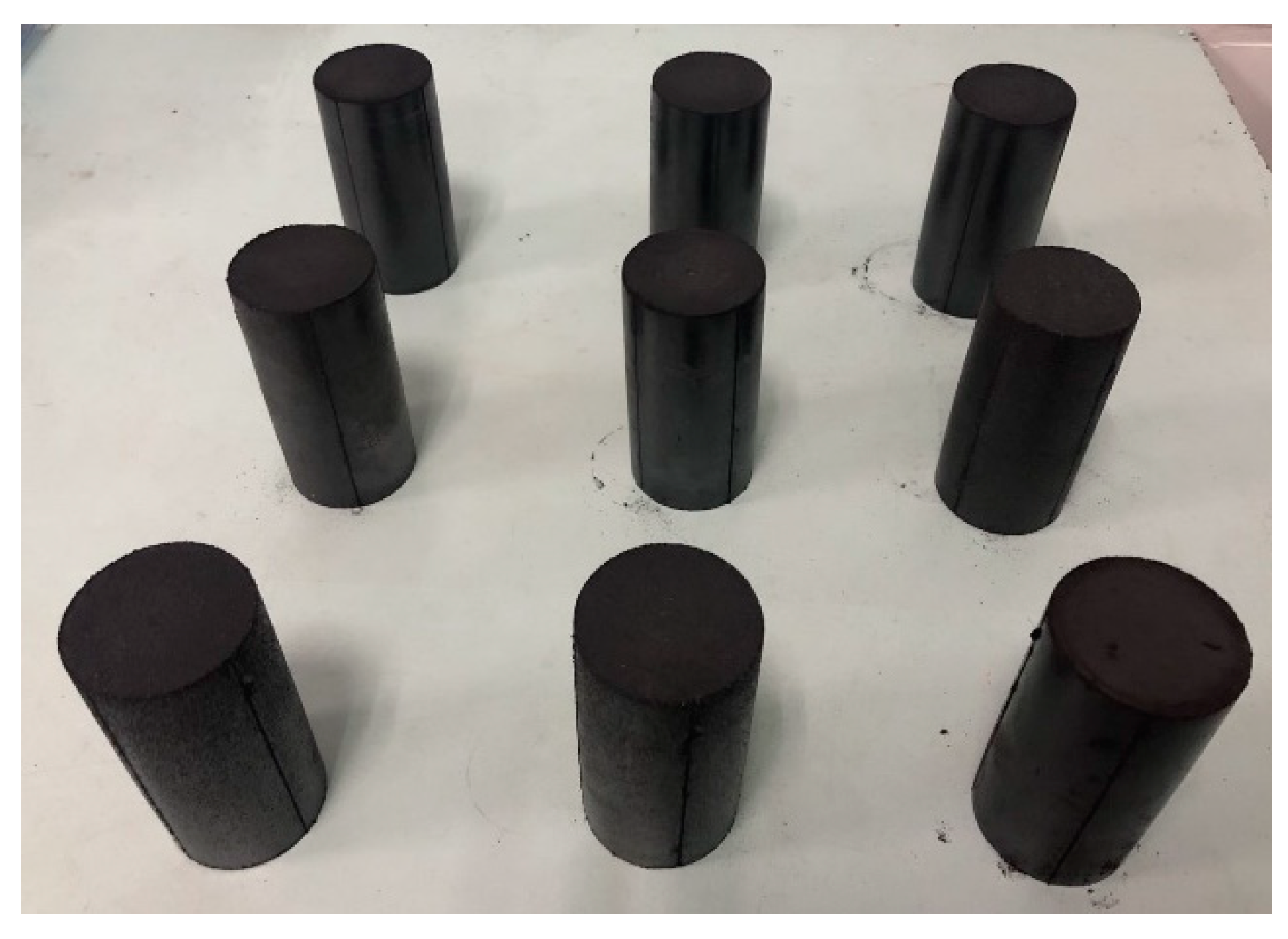
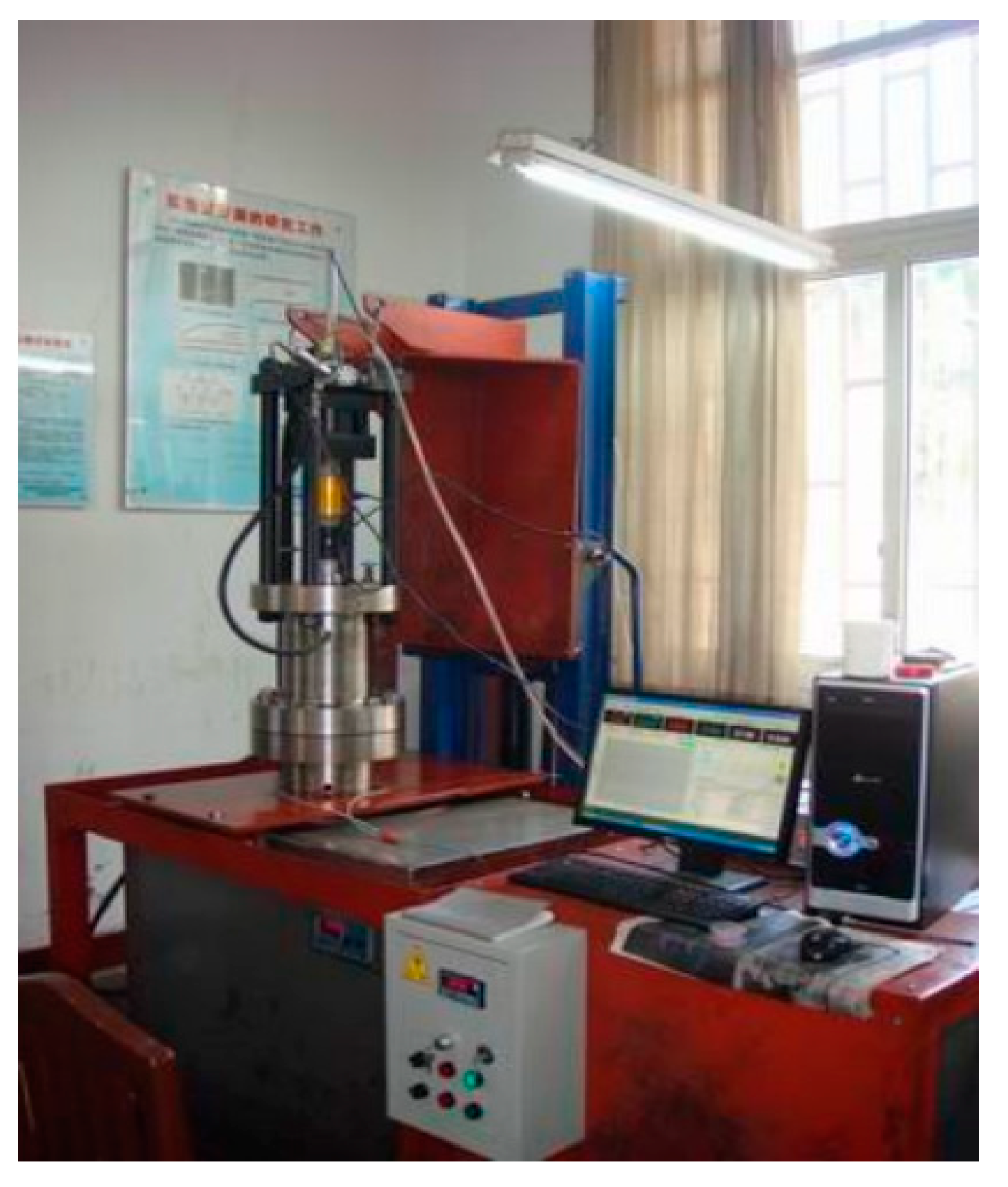


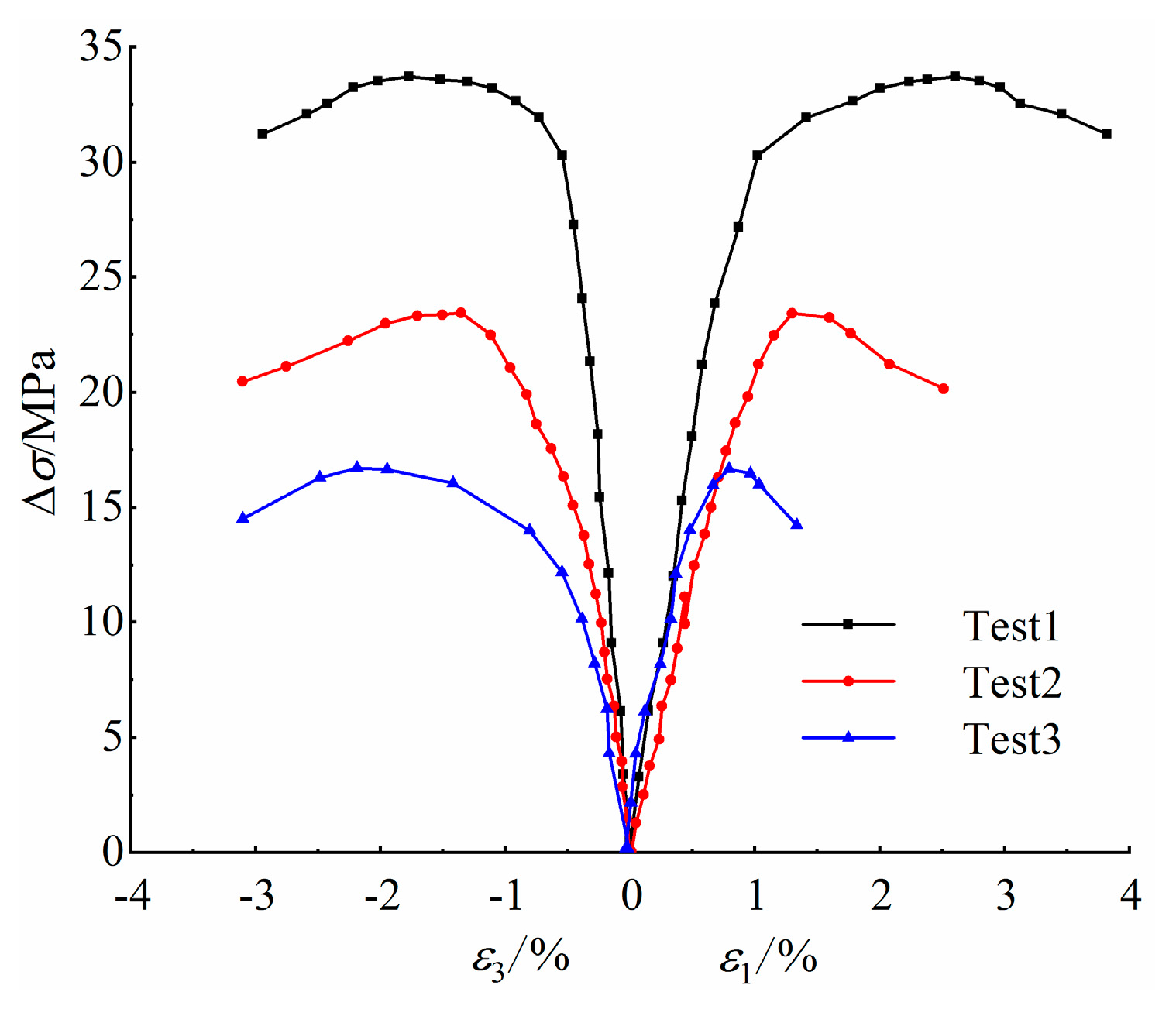
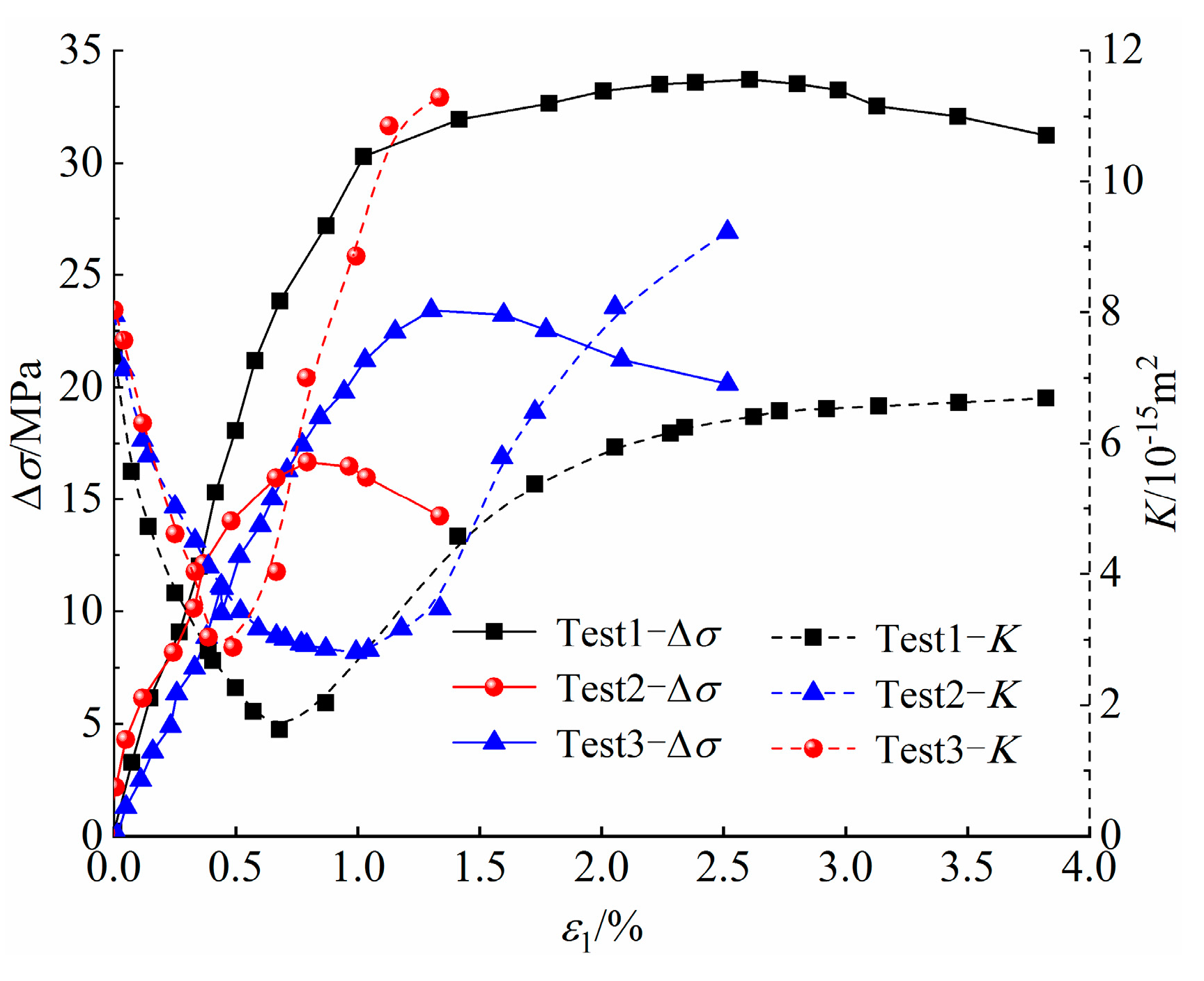
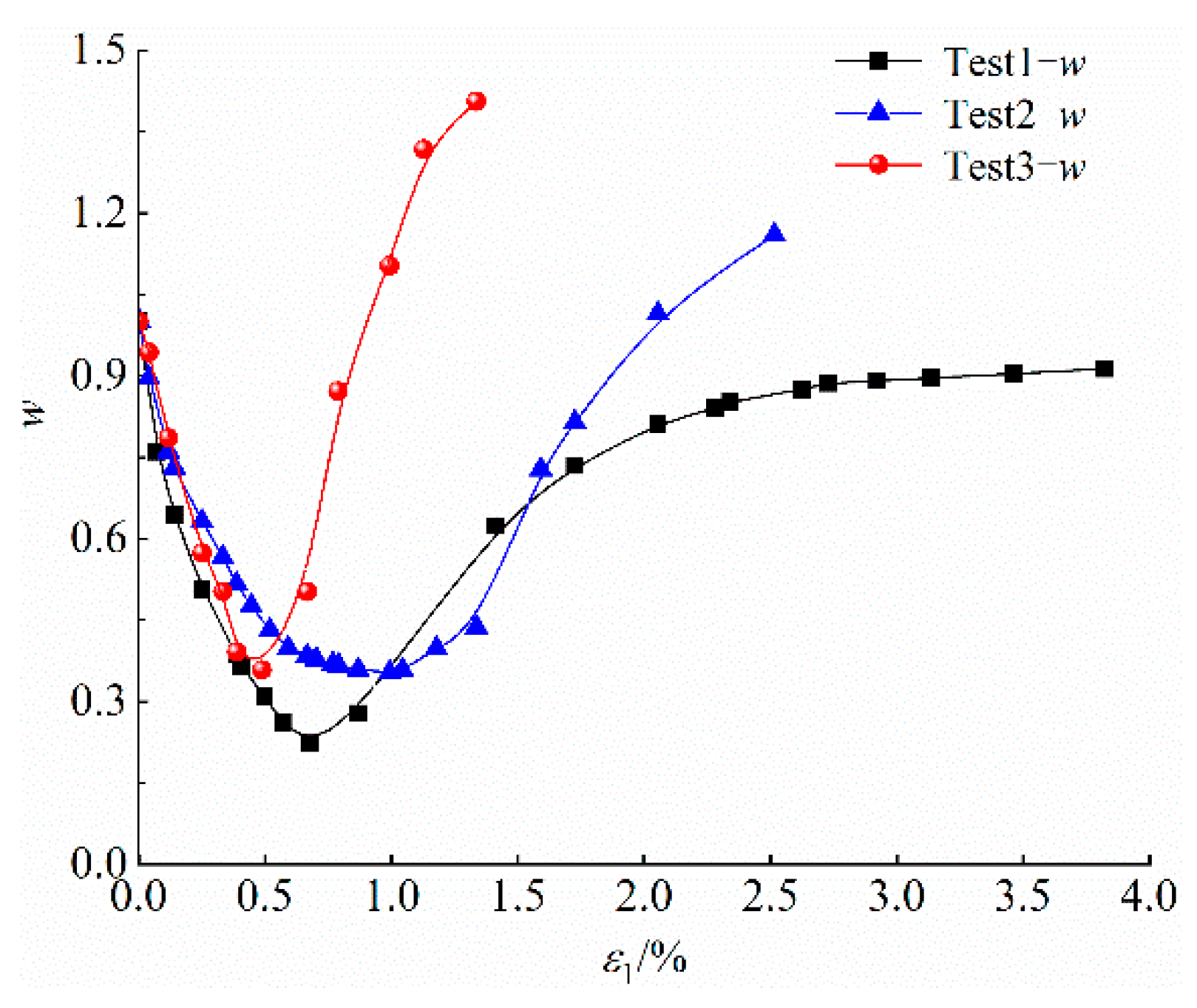
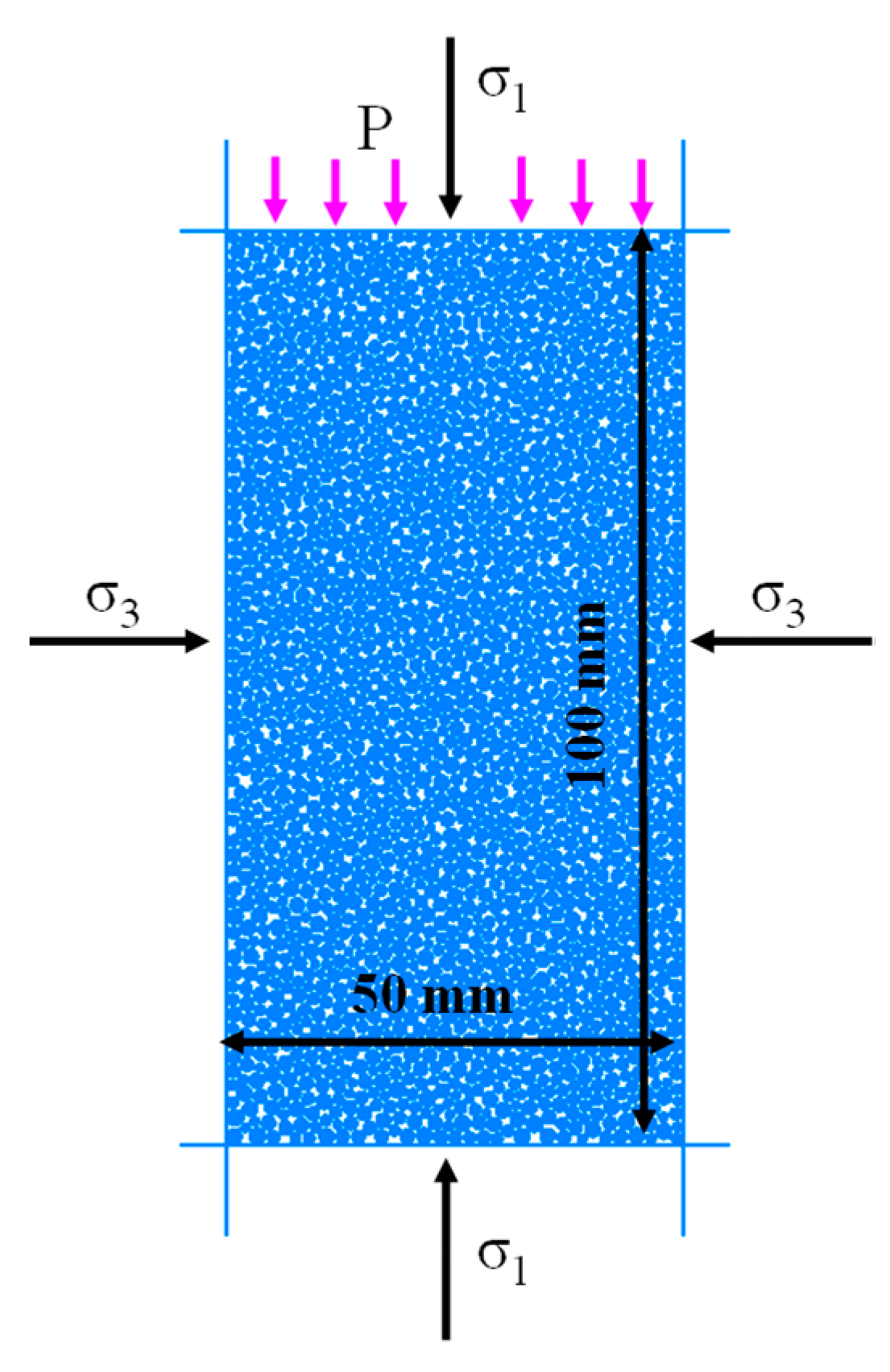

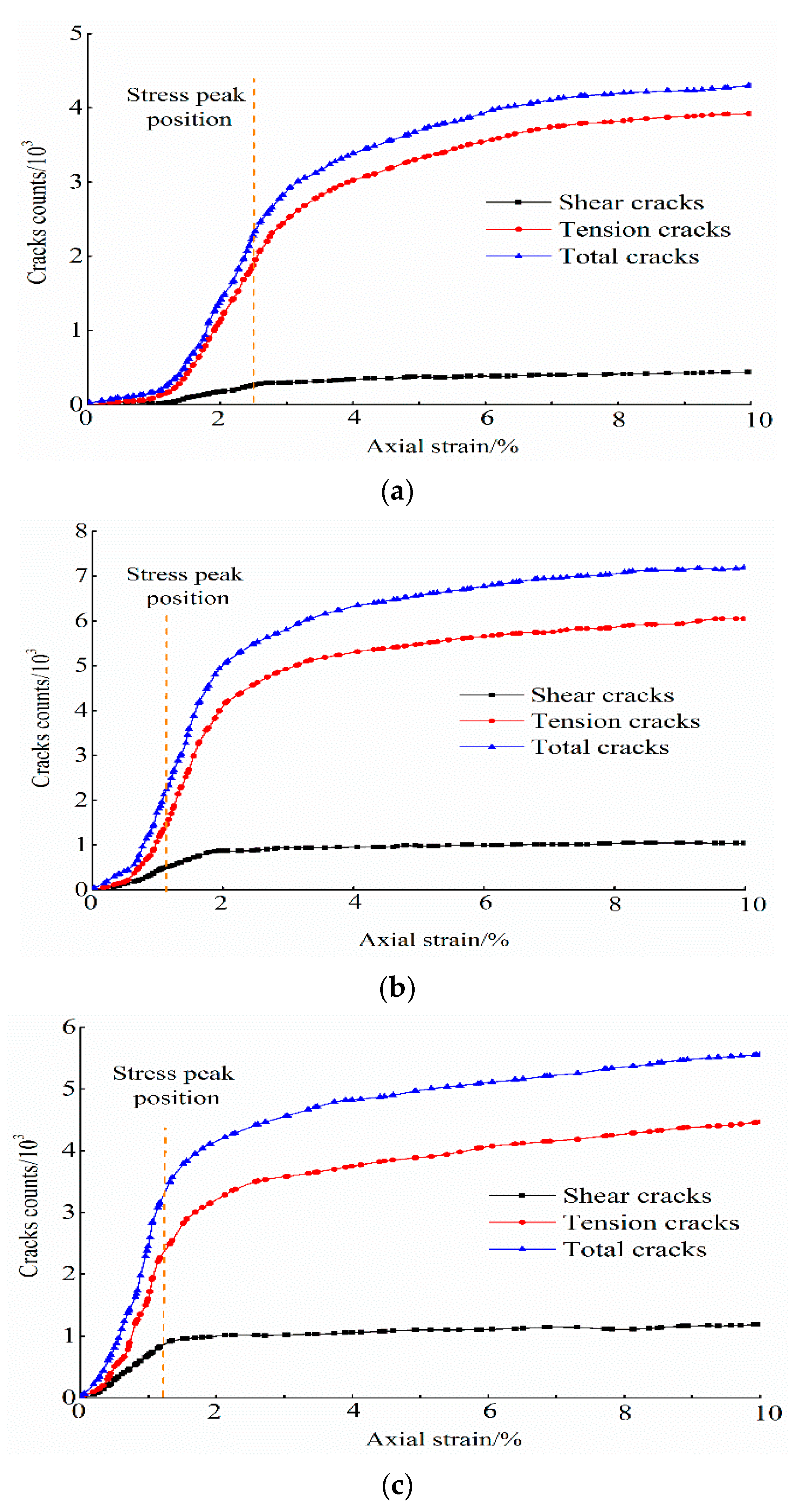
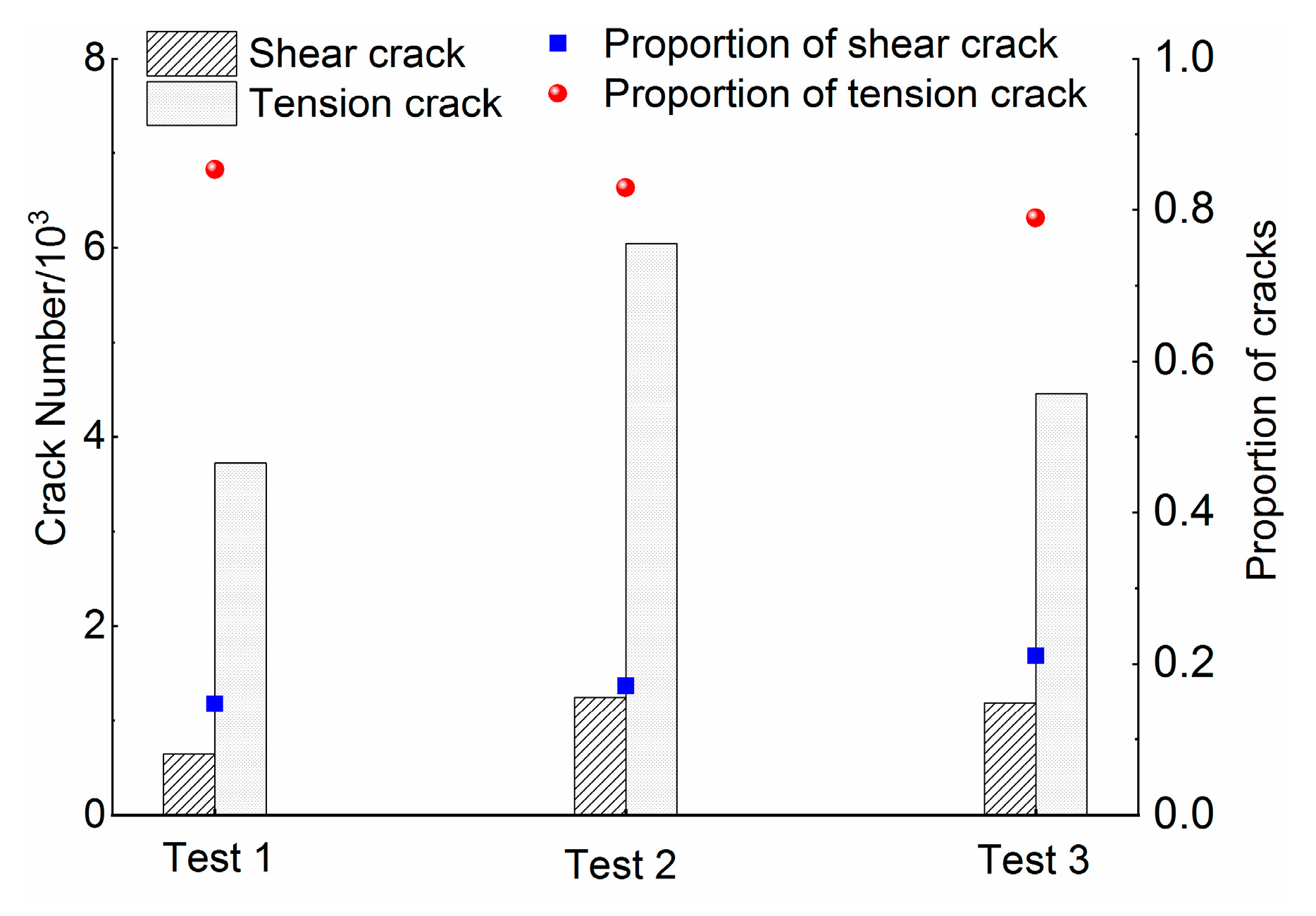
| Bulk Density (kN/m3) | Elastic Modulus (104 MPa) | Internal Friction Angle (°) | Tensile Strength (MPa) | Cohesion (MPa) | Poisson Ratio |
|---|---|---|---|---|---|
| 13.57 | 6.89 | 42.6 | 1.34 | 2.43 | 0.28 |
| Parameters | Value |
|---|---|
| Contact stiffness ratio | 2.14 |
| Contact modulus (GPa) | 5.1 |
| Friction factor | 0.4 |
| Parallel bond modulus (GPa) | 5.1 |
| Normal strength of parallel bonding | 4.6 |
| Parallel bond tangential strength (MPa) | 4.6 |
| Parallel bond stiffness ratio | 2.14 |
| Fluid Viscosity μ/(Pa s) | Fluid Volume Modulus Kf (GPa) | Residual Pore Size a0 (m) | Initial Normal Stress F0 (kN) | Time Step Δt (s) |
|---|---|---|---|---|
| 0.015 | 0.0096 | 1 × 10−3 | 5 × 103 | 0.1 |
Publisher’s Note: MDPI stays neutral with regard to jurisdictional claims in published maps and institutional affiliations. |
© 2022 by the authors. Licensee MDPI, Basel, Switzerland. This article is an open access article distributed under the terms and conditions of the Creative Commons Attribution (CC BY) license (https://creativecommons.org/licenses/by/4.0/).
Share and Cite
Sun, H.; Zhang, B.; Song, Z.; Shen, B.; Song, H. Mechanics-Seepage Experimental and Simulation Study of Gas-Bearing Coal under Different Load Paths. Processes 2022, 10, 2255. https://doi.org/10.3390/pr10112255
Sun H, Zhang B, Song Z, Shen B, Song H. Mechanics-Seepage Experimental and Simulation Study of Gas-Bearing Coal under Different Load Paths. Processes. 2022; 10(11):2255. https://doi.org/10.3390/pr10112255
Chicago/Turabian StyleSun, Haibo, Baoyong Zhang, Zhijun Song, Bin Shen, and Hongyu Song. 2022. "Mechanics-Seepage Experimental and Simulation Study of Gas-Bearing Coal under Different Load Paths" Processes 10, no. 11: 2255. https://doi.org/10.3390/pr10112255
APA StyleSun, H., Zhang, B., Song, Z., Shen, B., & Song, H. (2022). Mechanics-Seepage Experimental and Simulation Study of Gas-Bearing Coal under Different Load Paths. Processes, 10(11), 2255. https://doi.org/10.3390/pr10112255









